Laptop CPU battle: Apple M1 vs. Intel 11th-gen Core vs. AMD Ryzen 4000 - prudhommeeaddelartion
Apple's brand-new M1 processor took the laptop world by storm, with many proclaiming it had ended the PC's whole career.
Hyperbole and irrational fanboy flexing away, Apple's M1 is indeed a powerful chip. But to get a better feel against its coevals we sat down and retested a pile of current Windows 10 laptops to puzzle an musical theme where the M1 MacBook Air 13 lands in the pecking order of laptops.
While we don't have direct access to an MacBook Affirmative M1, our sister publication, Macworld does, thusly we cribbed from its enthusiastic critique of the 13-column inch MacBook Pro M1. Macworld also graciously ran a copulate of additional tests for our analysis. For two other results, we relied on published results from Puget Systems, a bespoke system builder that manufactures workstations and rolls its own productivity-focused benchmarks.
Our tests show the M1 MacBook Zephyr 13 performing identical well compared to equivalent weight PC laptops. You can parachute straight to our conclusion for the final depth psychology, simply if you wishing to dig deeper to see on the nose where and how the M1 does considerably, read on…
The laptops we tested
Apple's MacBook Pro M1 features its spiffy new M1 Arm-based SoC/Processor, a 512GB bespoke SSD, 16GB of LPDDR4X/4267 memory, a 13.3-inch 2560×1600 screen, and lap slant of 3.1 lbs.
For our Microcomputer comparisons, we decided to pickax from laptops that are correspondent in sized and burden:
- MSI's Prestigiousness 14 EvoRemove not-product liaison is equipped with a four-burden, 11th-gen Core i7-1185G7 with Iris Xe artwork, 16GB of LPDDR4X/4267 memory, a 512GB PCIe Gen 4 SSD, and a 14-inch FHD screen. It weighs 2.7 lbs.
- MSI's older Prestige 14 is equipped with a six-core, 10th-gen Core i7-10710U, GeForce GTX 1650 Liquid ecstasy-Q graphics, 16GB of LPDDR3/2133 memory, a 1TB PCIe 3.0 SSD, and a 14-column inch 4K screen. IT weighs 2.8 lbs.
- Lenovo's Yoga Little 7 has an eight-burden Ryzen 4800U with Radeon nontextual matter, 16GB of LPDDR4X/4267 memory, a 512GB PCIe 3.0 SSD, a 14-column inch FHD, and lap weight of 3.1 lbs.
- The Asus ROG Zephyrus G14 includes an eight-gist Ryzen 9 4800HS, GeForce RTX 2060 Max-Q graphics, 16GB of DDR4/3200 remembering, a 1TB PCIe 3.0 SSD, a 14-inch FHD cover, and a burden of 3.6 lbs.
Before you object to having the Zephyrus G14 laptop hither, pay close attention to the weight and size of the laptop. At 3.6 lbs., it's in reality very close to the weight of the Lenovo Yoga Slim 7 and the Apple MacBook Pro 13, which are each 3.1 lbs. We think on that point are indeed some people who might consider the Zephyrus G14 to get the surplus mogul its GeForce RTX 2060 Max-Q provides. Yes, the 180 watt great power brick adds even more weighting to the G14, but it may hardly be worth it to those folks.
We think discrete graphics are one of the overlooked features of the older MSI Prestigiousness 14 too—a laptop that weighs to a lesser degree the Lenovo Slim 7 and MacBook Pro M1, but features a GeForce GTX 1650 Max-Q GPU inside. In that location are indeed various compromises in the older Prestige 14 to get that GPU, which we elaborated in our groundbreaking review, but weight is typically the with child equaliser.
That's why the final laptop we included is rattling there for a raw operation comparison, since no unitary would consider it remotely in the socio-economic class of the laptops above:
- The Genus Acer Predator Triton 500 with a six-core 10th-gen Core i7-10750H CPU, GeForce RTX 2080 Super nontextual matter, 32GB of DDR4/3200 computer storage, a 1TB PCIe 3.0 SSD, and a 15.6-inch 300Hz FHD screen. It weighs 4.6 lbs.
We wanted this laptop particularly for its Core i7-10750H Central processor, which is precise similar to Intel's 8th-gen and 9th-gen "H" classify CPUs found larger laptops such as Apple's MacBook Pro 16. Most of the laptops here feature lower-top executive CPUs, then we wanted to see simply how swell the M1 and new chips in smaller laptops compared against a chip that sucks down many more Isaac Watts.
Of all of the chips here, Malus pumila's M1 uses TSMC's most advanced 5nm process, with the two Ryzen laptops using TSMC's 7nm. Intel's 11th-gen "Tiger Lake" Core i7-1185G7 is connected Intel's newest 10nm cognitive operation, while the Substance i7-10710U is like the Core i7-10750H and built connected Intel's—how lav we say this politely?—wise 14nm process.
Next page: Performance benchmarks
Malus pumila M1 vs. Intel 11th-gen Core vs. AMD Ryzen 4000 performance benchmarks
Cinebench R20 performance
We'll inaugurate our results with Maxon's sr. Cinebench R20. It's a 3D modelling benchmark built on the company's in-house engine misused in its commercial Cinema4D product. Cinebench R20 had versions for x86 connected Windows and x86 on MacOS. Maxon's newer Celluloid R23 offers indigen support for Apple's M1 chip, but the elderly R20 version must practice Apple's Rosetta 2, a technology that handles just-in-time translation of x86 instructions to Arm from non-native encipher.
 IDG
IDG Having to pay a time period version penalty typically blows chunks so we expected the M1 to cough up furballs, but it's well-known now that Malus pumila's limitless financing and hard work has paid off handsomely. Yes, you can look at the black legal profession in the chart and see that the red Ryzen 4000 chipsstomps the M1 into the ground. And yes, the quad-core Core i7-1185G7 is faster too, despite the Mac have Ashcan School physical cores, but remember the translation penalty the MacBook is paying you said it much it saps performance. This is an impressive showing by Apple.
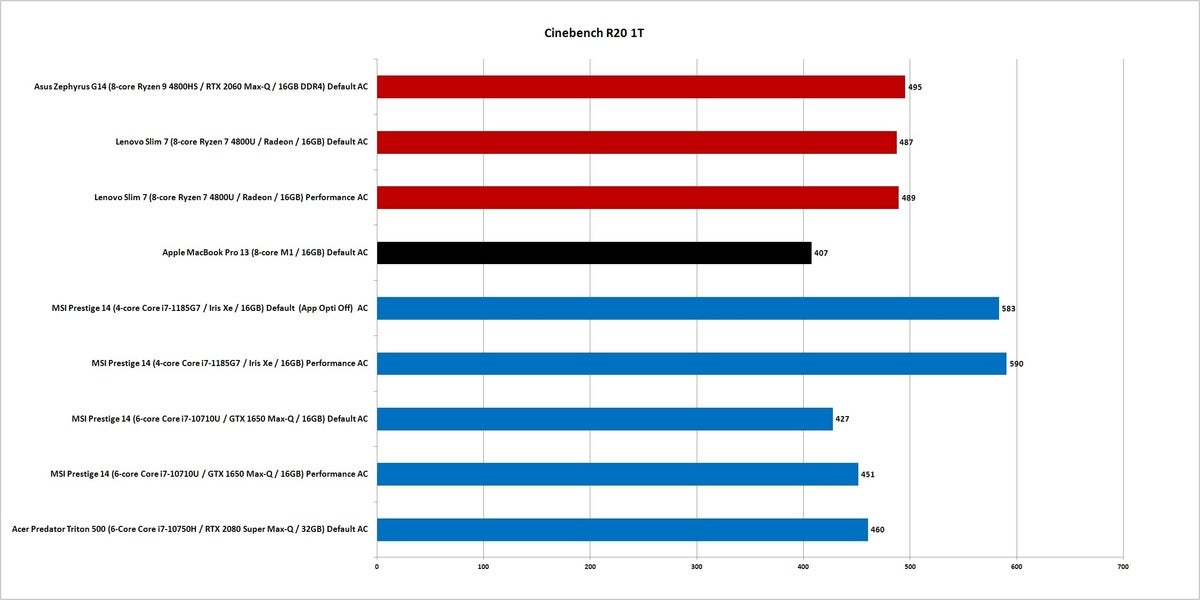 IDG
IDG Cinebench allows you to measure a single-rib performance as well. For the x86 side, where Ryzen previously beat Core, it's now flipped as we visualize Intel's new 11th-gen Core i7-1185G7 leading the way. The Apple MacBook Pro M1? It's really non bad again when you consider that Orchard apple tree is paying a muscular version penalty. Or s think information technology to glucinium as high as 30 percent, which coincidentally is matches the fee Apple takes from App Store purchases, sparking its state of war with Epic. We don't know if the two are related, but we'd guess the M1 picks up much more mileage with autochthonic encrypt.
Cinebench R23 Performance
Maxon released a new rendering of Cinebench R23 with native M1 support, but in that respect are another operative changes which should be mentioned besides. With Cinebench R20, the benchmark would guide render a single scene and acquire a score based on its mop up. With Cinebench R23, the render scene is the same, just Maxon has interestingly changed it to yield the same scene over and over for 10 proceedings. The bench mark will even run on the far side 10 minutes if the scene is still rendering when the timer hits zero.
 IDG
IDG Connected a sestet-core Intel H-class chip, Cinebench R15 takes 34 seconds to complete patc Cinebench R20 takes about 108 seconds. With Cinebench R23 it now takes a minimum of 600 seconds to run under the young method. On a desktop or workstation with ALIR more cooling it's not an issue, but on laptops an all-core test that runs for at least 10 minutes can be far harsher—especially along CPUs that either make more heat, or laptops with many limited cooling. It's actually called a "throttle mental testing" which is a antithetic method than in front for Cinebench.
None of this bothers Apple's M1 much though. Supported TSMC's most advanced 5nm process, it's a stone cold killer whale, with Macworld coverage no buff noise at all during the unravel. That bathroom't be said of the x86 laptops, which all vary from fairly quiet to a little rackety.
The performance is impressive though, with the eight-center M1 Mac now ahead of the four-core 11th-gen Tiger Lake as well Eastern Samoa the older six-core Core i7-10710U. But if you give Intel's elder six-core more thermal head elbow room information technology's almost dead even off with the silent M1. An eight-core variance of an Intel H-chip would be straight faster obviously.
AMD, however, just shrugs at all this and yawns as its eight-core Ryzen 4000 chips easily beat all comers when set to their performance modes.
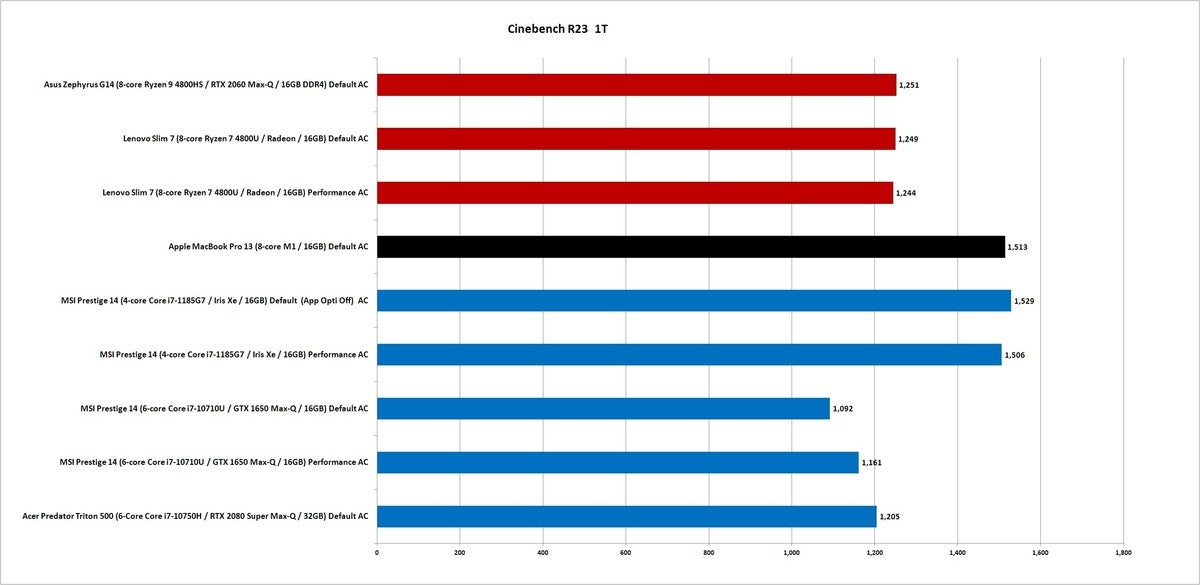 IDG
IDG Single-threaded performance probably matters more for what most people do and the M1 doesn't disappoint there either. Neither does Intel's Core i7-1185G7, to Be mediocre. Its single-threaded prowess has pushed excursus Ryzen 4000 and you see that here where both the M1 and the Core i7-1185G7 are basically laced in Cinebench R23. At that place's some conjecture that "we're just not testing x86 right" American Samoa Usman Pirzada argues at WCCFtech. However, Joel Hruska at Extremetech (World Health Organization worked on the results with Usman) argues the ball is really back in Intel and AMD's court for how to computer address the limitations.
The important take away is the single-threaded performance on the M1 as well as Intel's Panthera tigris Lake is nothing to dismiss.
But Eastern Samoa we said, there is indeed a cost to be had for when you run every CPU core that ossified on a laptop computer. Cinebench R23 allows you to really turn off the "Throttle Test," so we did that to record scores of Cinebench R23's multi-core benchmark in a more traditional azygos render scene. Laptops that crapper benefit from lone running full tilt for three proceedings versus more than 10 transactions get a sufficient 6 to 8 percent boost. The Ryzen 4000 laptops actually overt improving their performance gap against The M1 and Intel chips even far when the run over clip is shriveled.
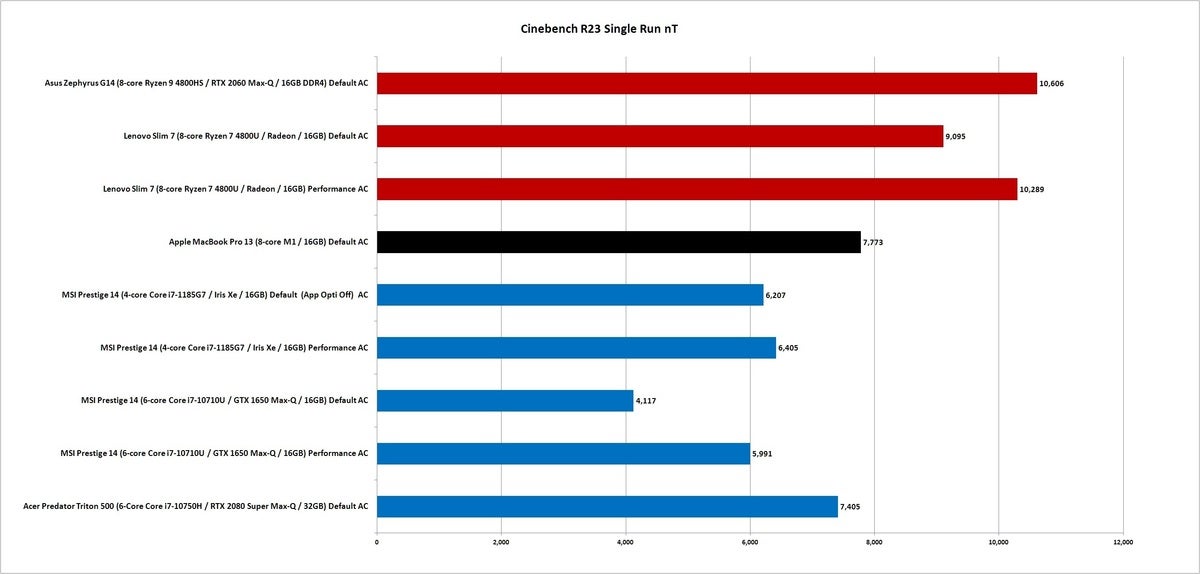 IDG
IDG This just goes to show you the boosty nature of laptops improves from threatening the thermal load, putt in more fans to dissipate that outflow load, or simply fashioning your CPU much efficient.
You can see that in the next graph, where we took our Cinebench R23 single-bleed result and compared it to the result of Cinebench R23 in its nonpayment throttle test. The laptops that face more of a thermal limit all show 6 to 8 percent melioration when the load is hack by two-thirds, leave off for two: The Apple MacBook Affirmative M1 and the Acer Predator Triton 500.
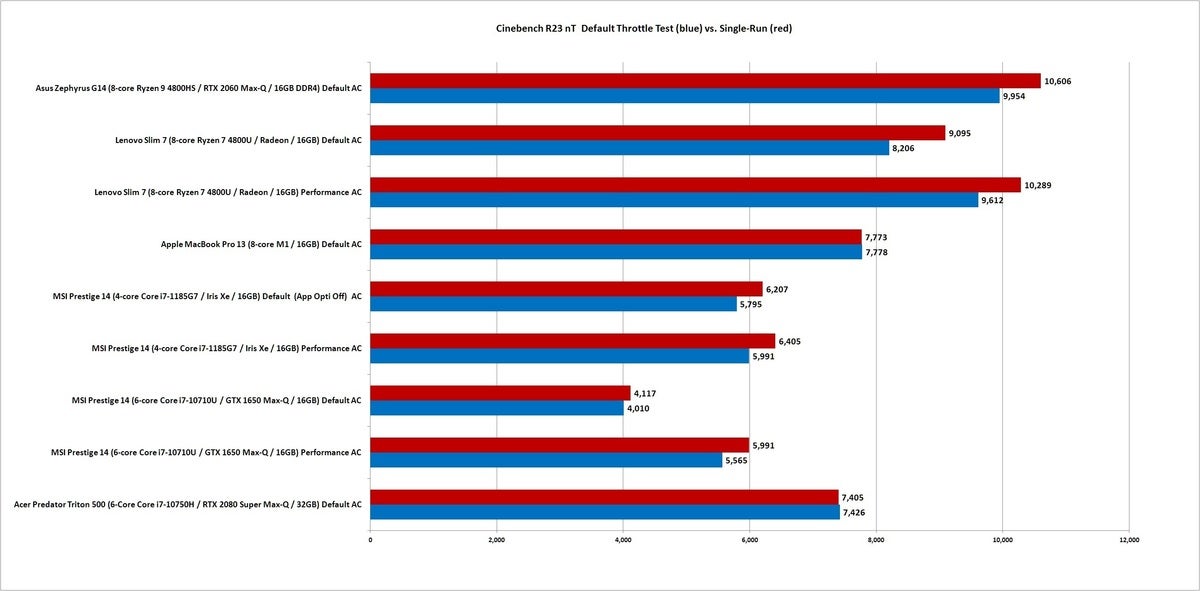 IDG
IDG In the Predator Triton 500's case, its larger chassis, additional heat pipes and additional venting means the CPU is just never generating sufficient fire u to hit that thermal wall, even with a fairly high-wattage Intel potato chip inside. Its six cores of 14nm oldness still nates't outpace the other chips, but the thermals clearly have no issues. That shouldn't surprise, as the Triton 500's cooling was designed to keep the GeForce RTX 2080 Super Max-Q running smooth likewise, so running a uncontaminated C.P.U. load substance the cooling headroom is far higher.
The MacBook In favou M1 is every bit impressive for a different argue. Despite being a spiritless and light laptop, information technology right doesn't seem to generate enough heat to hurt it. You force out guide Cinebench R23 for 3 minutes or 10 minutes—information technology just doesn't handle. That's something that should be appreciated.
And yes, the older Prestige 14 with its 14nm Comet Lake U chip connected its default setting basically doesn't motility so much because happening default, it's likely so lackadaisical it doesn't thing in any event. It also benefits from cutting the interpret time down along its public presentation setting though.
V-Light beam Next Performance
Up next is Chaos Groups' V-Ray Next benchmark, another 3D rendering test. Like Cinebench R20, it's non-aboriginal to the revolutionary MacBook and loves more than cores. With the M1's version tax, V-Shaft of light Following loses much performance, but information technology's still enough to to virtually isochronal Intel's four-core Tiger Lake part. AMD and its Ashcan School-core Ryzen CPUs over again gives all others a good Lord Nelson Muntz gag.
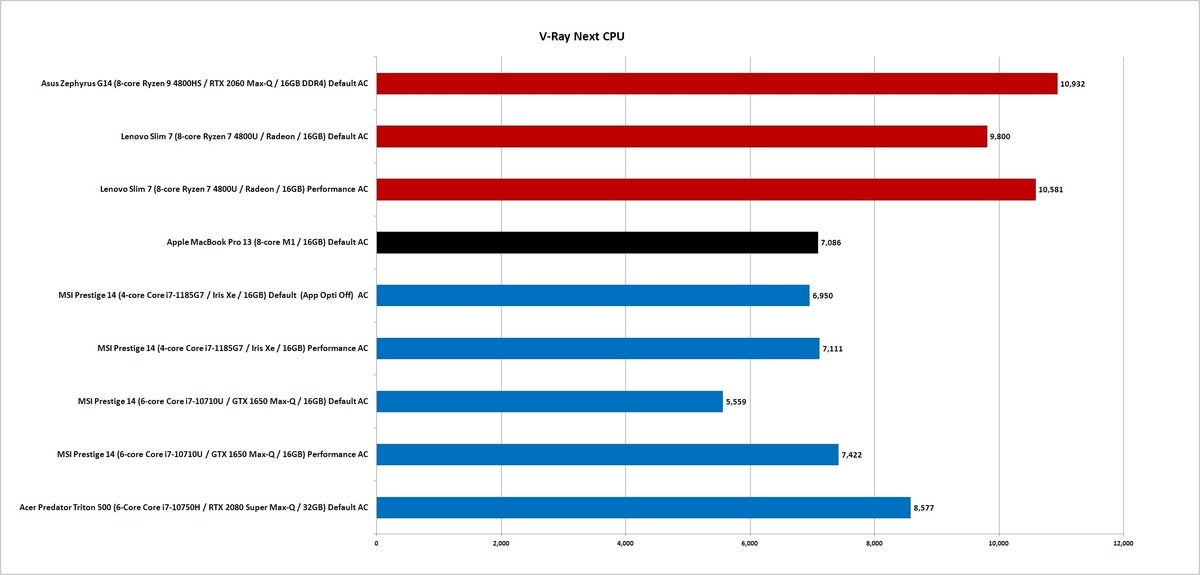 IDG
IDG V-Ray allows you to as wel run a render on the GPU instead, which is increasingly popular among advanced engines. Of the chips with onboard graphics, the Ryzen 7's Radeon GPU cores put AMD in front, Apple's M1 falls in the centre, and Intel lags a little behind.
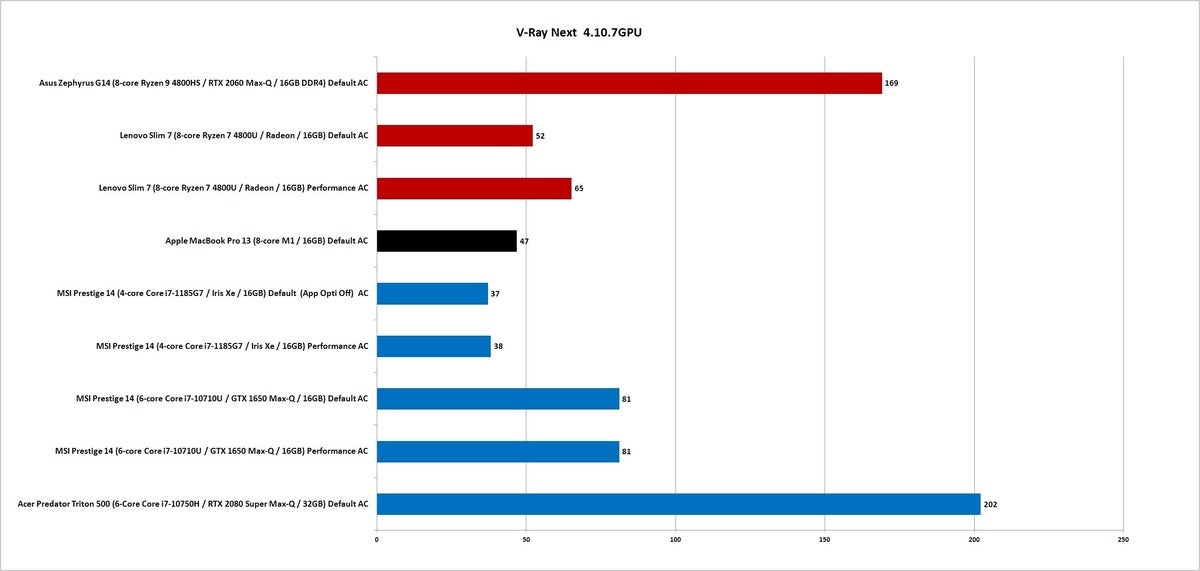 IDG
IDG GPU rendering performance, obviously, gets better with more powerful GPUs. The GeForce RTX 2080 Tiptop Max-Q in the Triton 500 thus wipes the floor with everyone other, while the GeForce RTX 2060 Max-Q doesn't do too shabby either. This, candidly, is one of the reasons we imagine the Asus G14 is still thusly persuasive. Its 0.5-lbs heavier than the laptops with onboard graphics simply that GeForce RTX 2060 Max-Q makes a yuge difference in performance.
Rise of the Tomb Raider Performance
We old just one pun to view the art carrying out of the M1 compared to Windows laptops. We ran Rise of the Tomb Raider set to 1920×1080 on the Windows laptops on high and compared information technology to the result Macworld got along the MacBook Pro M1 running at 1920×1200 connected High.
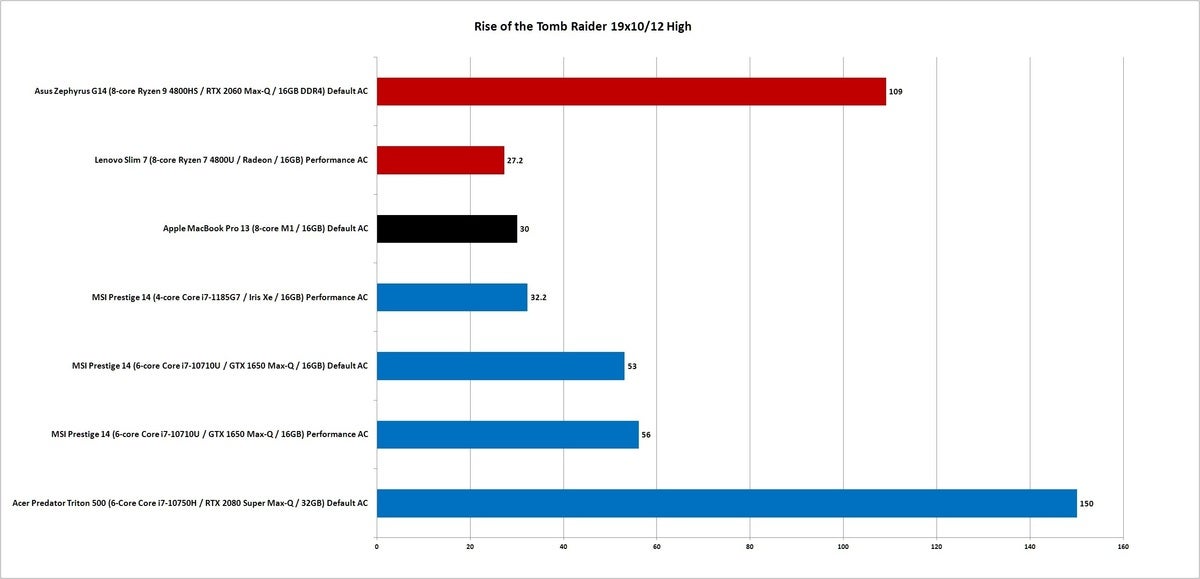 IDG
IDG Patc the integrated graphics in Intel 11th-gen laptop computer is in frontal of AMD and Apple's aboard GPUs, let's just now call IT a connect and jibe all three would be capable of restrained gambling at lower resolutions. Less intense games would be easier of course. No of them would compare to a laptop computer with a separate GPU though. As you crapper see, the GeForce GTX 1650 Easy lay-Q walks off from the unsegregated graphics laptops, and we'll remind you again the Prestige 14 with the GTX 1650 inside weighs less than 2 of the other laptops.
Of course, we can't discount that Asus Zephyrus G14 nor the Piranha Triton 500 either. If you rattling intend to do anything diagrammatically intense, get a laptop with discrete graphics in it.
Still, the three integrated graphics laptops do fairly well. We wouldn't even incommode trying to comparison to laptops with Intel's UHD graphics. Focusing on the MacBook M1, it again offers very impressive performance. But yes, if soul is departure to squawk at you about its graphics functioning, pretty overmuch any Windows laptop with half-decent discrete art leave eat its dejeuner, and for less money. We're pretty certain that a budget Negro Friday gaming laptop sold for $700 is likely to whoop the MacBook Professional M1 in games thanks to its discrete graphics chip. And no, we canful't run Counter Strike: Global Operations or Ruddy Dead Redemption Cardinal along the new MacBook Pro M1. You know why so don't ask.
PugetBench Photoshop Performance
All this talk about 3D rendering, single-threaded performance and blah, bombast tests probably sound like what your dog hears when you bawl out him for pooping on the rising carpet. In real world, mass use these things called applications. Among the most popular is Adobe's Photoshop.
To test its performance, we used Puget Systems' PugetBench, which is where we also sourced the M1 execution results. Puget Systems looked at the M1's performance to help people have a clearer understanding of where the freshly MacBook In favour of M1 stands in relation to desktop performance (which will always be faster). Disdain the flexing from Macintosh super fans, even an old desktop Personal computer is faster than the MacBook Pro M1, A Puget Systems found.
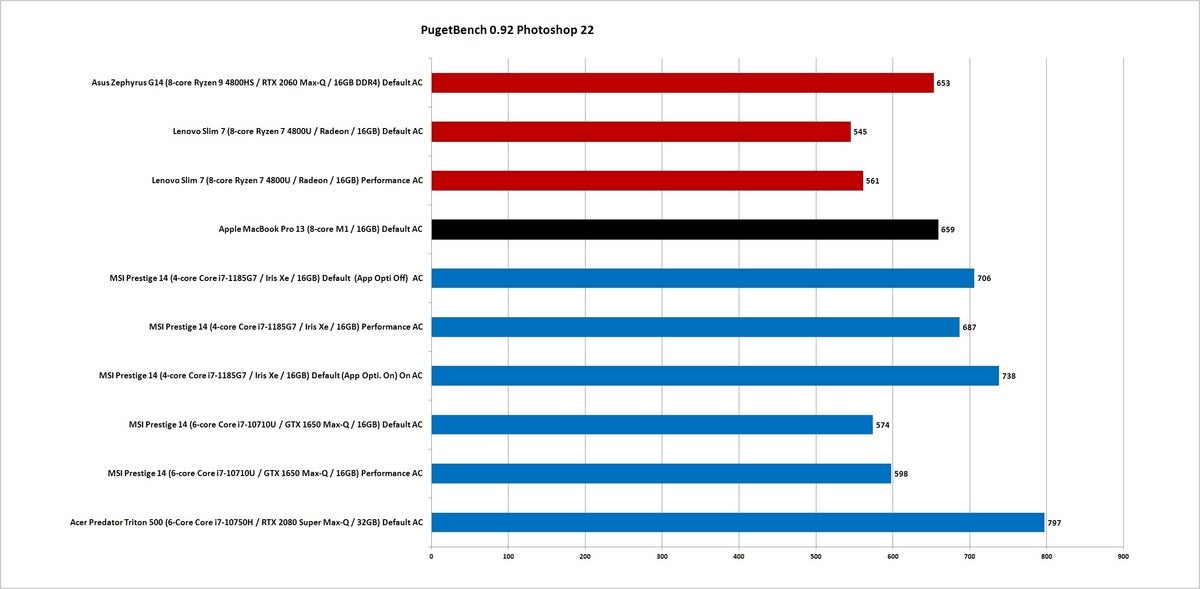 IDG
IDG Comparison it against contemporary laptops, though, shows the M1 does quite well with performance, surpassing the Lenovo Yoga Slim 7 and its Ryzen 7 4800U chip. It's around tied with the Ryzen 9 4900HS in the Zephyrus 14 overly. Photoshop has traditionally been very single-threaded, so we'ray non too surprised to best honest. Single-threaded CPU performance never really was Ryzen 4000's strength. Intel's 11th-gen Tiger Lake chip is in front line of the MacBook In favou M1 by a small number.
Likewise of involvement are the results from cardinal older 14nm-based Intel laptops. The Prestige 14 with its GeForce GTX 1650 Max-Q and very boost-limited flooding clocks doesn't quite wage away the dividends you'd expect, so we really think the test makes far sparser use of the distinct GPU than you might think.
What doesn't disappoint though is that relatively large Genus Acer Predator Newt 500. It's the overall winner. We impute that to its distant better temperature reduction, which enables higher-clock speeds; perchance its GeForce RTX 2080 Super Max-Q GPU; and, crucially, its 32GB of base store. Raging Photoshop users should always choose for as so much memory as you can pack into a laptop.
PugetBench Premiere Execution
Heaving on to something far stiffer, we also secondhand PugetBench Premiere on the laptops. Since the examine takes over an time of day and requires as a great deal performance atomic number 3 you can get, we've decided to limit IT but to the laptops in their various performance modes. Against laptops with unsegregated graphics—the Ryzen 4000 Slim 7 and the 11th-gen Prestigiousness 14 Evo—information technology's a win for the MacBook Pro M1. More so against the Slim 7, which waterfall behind farther than expected.
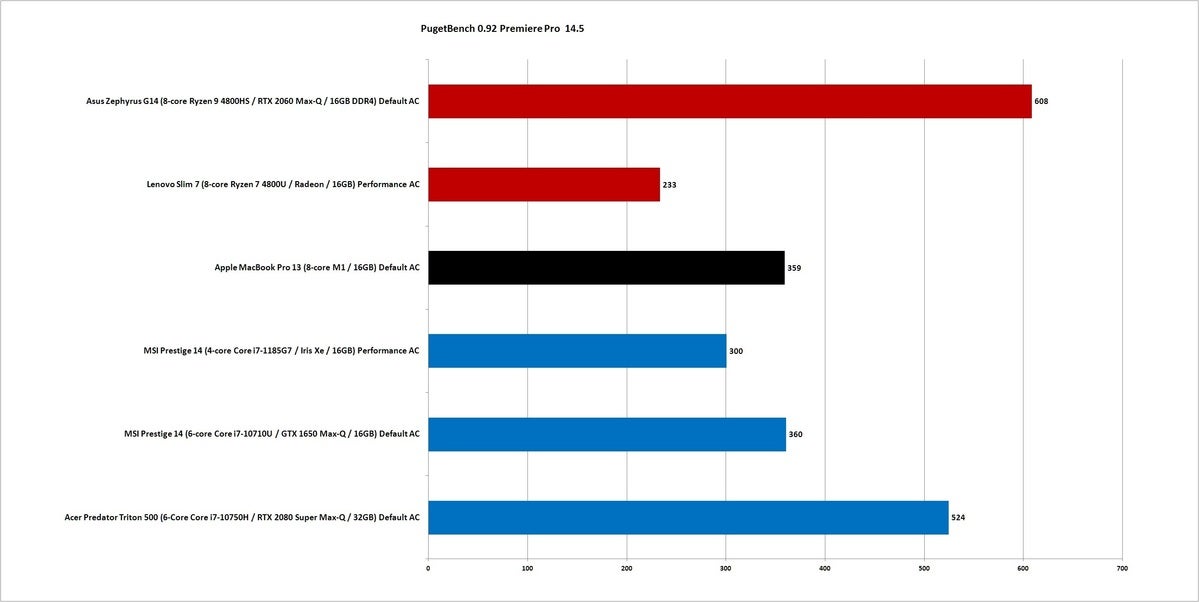 IDG
IDG Laptops with discrete graphics fare better, with the GeForce GTX 1650 Liquid ecstasy-Q in the experienced MSI Prestige 14 pull even with Apple's M1. The GeForce RTX 2080 Max-Q in the Acer Predator Triton 500 has no problems leaving the smaller laptops far behind though. The compact Asus ROG Zephyrus G14 with its 8-core Ryzen 9 and GeForce RTX 2060 Max-Q which dusts off all comers.
This belik indicates that GPU encoding capabilities matter for how PugetBench sets its test upbound. When balanced with a multi-core chip, it's a successful combination overall. Still, it's a good showing for the M1 Mac, but realistically, it's probably going to be slower than a budget gambling laptop computer in many Premiere tasks.
The overlarge question is how much of a encouragement the M1 gets once Adobe offers native support in its apps. Since Adobe's products are so vast and what people do are so varied, it's pretty tough to say if the native performance boost will be as mammoth as we see in Cinebench. There are with great care many things being touched. We fundament say there will indeed a performance find—just nobody knows how big it will be.
Topaz Gigapixel AI Performance
One Thomas More chore we wanted to throw at the laptops uses advanced AI features. We find that in Topaz Laboratory's Gigapixel Bradypus tridactylus coating, which uses machine learning models to upsample images in a method that can be far more effective than traditional elaboration techniques.
For our examination, we took an image of a US Melody Pull up F-22 Raptor shot in 2010 on an 8.2MP Canon EOS 1D Mk IIn DSLR. We prey the double into Gigapixel AI and task it with growing the resolution past 6x. The application uses Intel's OpenVINO framework and is quite impressive—on Intel hardware. Since Macs up hitherto have been supported Intel, that's been a plus for the some Topaz Labs customers.
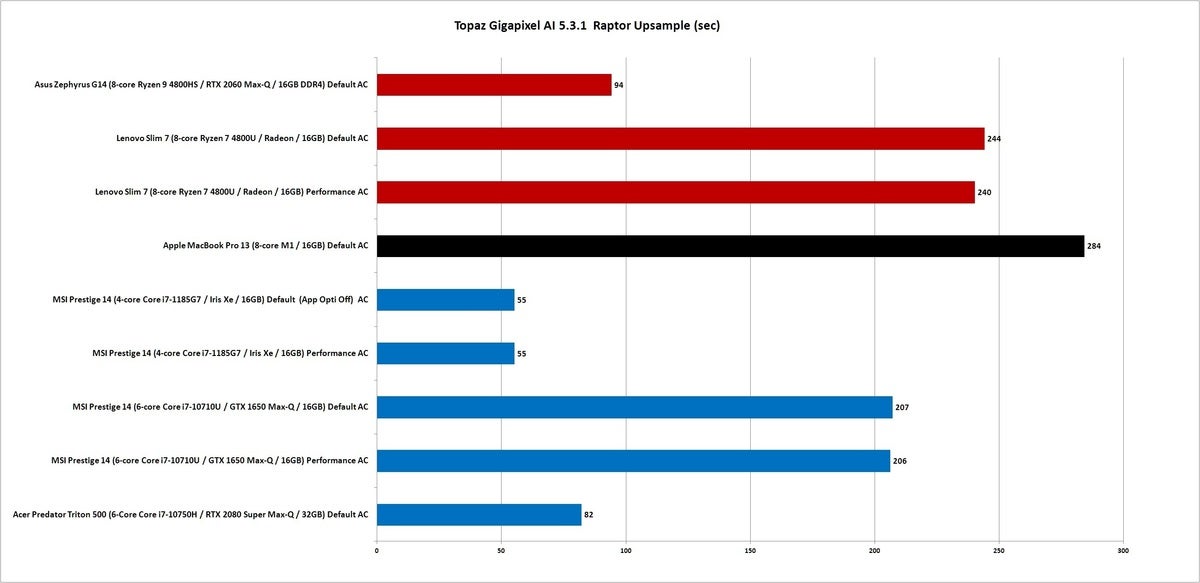 IDG
IDG Macworld ran the corresponding physique of the app on the MacBook Pro M1 with the very settings that we used on our Windows 10 machines. If you read our 11th-gen Tiger Lake trailer, you know that Intel's new-look CPU rocks the Ryzen 4000 chip. It's fair to say that IT's a slaughter for the Slim 7 laptop with its Ryzen 7 4800U. The 11th-gen Tiger Lake chip also easily runs its 14nm sibling in senior Prestige 14 off the field of study.
And yes, the MacBook Pro M1 performs the worst of each of the laptops here. We're talking about 1 minute for the 11th-gen Intel chip in the MSI Prestige 14 Evo versus honorable below 5 minutes for the MacBook Pro M1. That's for just a single trope, too.
Gigapixel AI also supports discrete graphics, which actually helps the Zephyrus 14 and Marauder Triton 500 abide in the game. But even with their much quicker distinct GPUs they're silence significantly slower than the 11th Tiger Lake chip.
In the past, AMD would throw it back in our aspect past expression that such specialty apps are misused aside further, far fewer people than fifty-fifty 3D modelling surgery a telecasting encoder. We suspect Apple fans would say the same matter—and mean that once Gigapixel Bradypus tridactylus is updated to support the MacBook M1 and its own inference engines, the M1 will cold better.
In a perfect world, yes, but we really don't know if surgery how long that will take. We should also point out this is a real application beingness used aside an untold keep down of photographers and digital artists.
Apple M1 Rosetta 2 cost
There have been plenty measurements of the translation monetary value needed to make x86 apps run on the MacBook M1, but we wanted to take yet another stab it. For that we decided to wont Cinebench R23 and Cinebench R20. As we said earlier, R20 is inbred to Intel-supported Macs, while Cinebench R23 is not. Cinebench R20 bases its tally along a single submit, while Cinebench R32 bases information technology on multiple renders by default. To see if they compare, we timed how long it takes to run a single render in both versions. On the Windows version, it's within the leeway of stop watch error on the MSI Prestige 14 Evo. That's not the case with the M1.
Keep on in brain when you look at the graph under that the shorter legal community indicates higher performance American Samoa we're looking how long it takes to render the scene.
 IDG
IDG Since both versions render what appears to atomic number 4 exact same frame, we can go steady the rendition time for both multi-threaded and single-threaded public presentation is most 28 percent less going from the translated interpretation to the indigen version of Cinebench on Apple's MacBook M1. That's real not bad, and succeeding with what others have seen the cost of the Rosetta 2 to be.
What's a little freaky is there's another way to bleed Cinebench R23 that forces the M1 to run it translated: Order the comprehensive binary to put in the Intel translation of it, rather than the M1-pure version. Macworld again graciously united to run IT this way and the result was significantly worse.
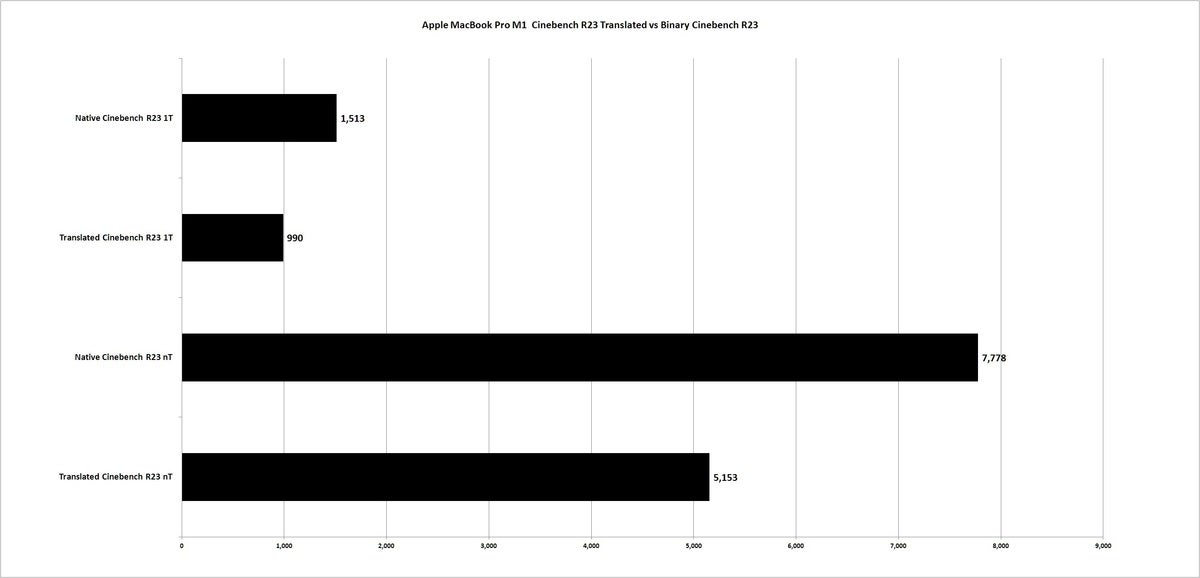 IDG
IDG Here's the default 10-minute run of Cinebench R23 on the MacBook Pro M1 using the native-binary and the Intel-binary. We're looking at closer to a 50 percent hit from using the Rosetta 2 transcriber to spend a penny the x86-code run around on the Arm-based M1 chip. That's not bad.
The big takeaway? Package that gets converted to native code on the M1 should almost always pick astir very large gains in carrying into action. And for applications that never get converted to native code, you'll e'er be paying a very hefty performance task.
That's bad, but you need to keep it in context. Overall, Rosetta 2 and the M1 is still mostly a success for those WHO had performance concerns. And if you're wondering why populate had concerns over performance, you fire see that below, where we ingest Cinebench R20 (non-native along the MacBook Pro's M1) and dial in a score generated on Microsofts Surface Pro X tablet.
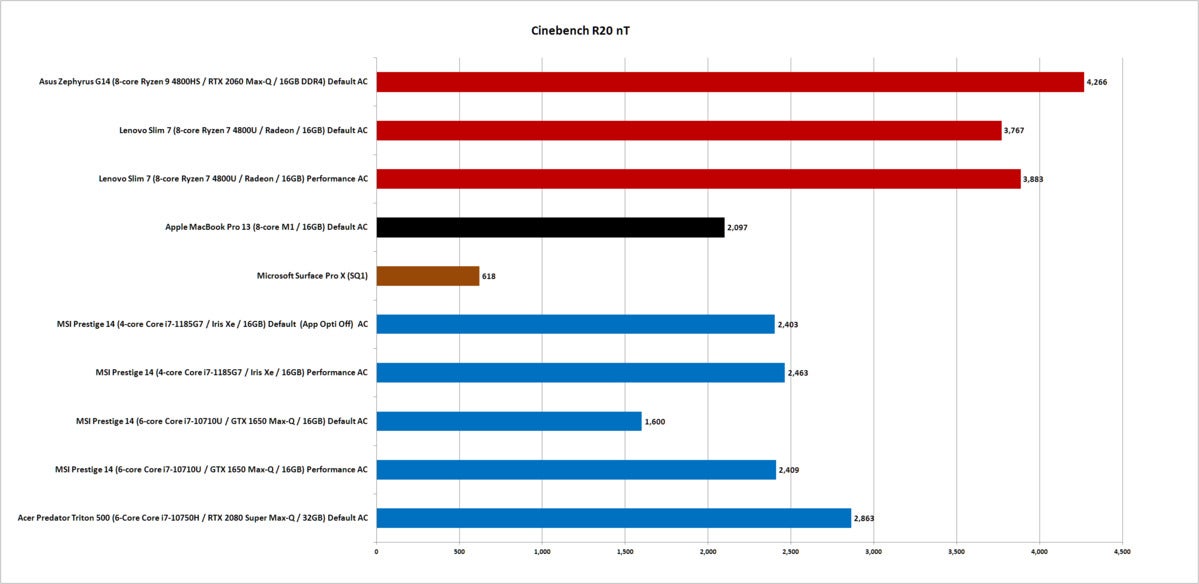 IDG
IDG The Surface Pro X tablet is unique among PCs because it's based on Qualcomm's custom SQ1 chip built for Microsoft, spurting on Arm computer architecture rather than traditional x86 cores. This week Microsoft released its beta 64-flake support and let's just enounce it doesn't perform nearly as fortunate as Rosetta 2 does connected Apple's M1 chip. Our Turn up In favou X versus MacBook M1 equivalence contains much deeper entropy, but Arm on Windows has never looked worse.
Conclusion
In now's technology circles, many people have retreated into their corners, with irrational fans choosing to always cheer for their team up and give no fourth part to competitors—even if the other team won. That shouldn't be some rational person's perspective because ultimately, these are just companies looking to take your money. It's also non classy.
 Malus pumila
Malus pumila MacBook Pro M1
With that said, we think Apple should be applauded for what information technology has pulled off with ithe new M1 chip. It offers truly amazing performance that looks like it can express the Macintosh down the fork of the road away from the world of x86. You can arguably say Macs built connected the new M1 will glucinium worthy of the heritage of the Mackintosh appoint, which hasn't been the case over the last some years. With the M1 and Apple's future iterations, heads can be held soaring again.
Yes, there will be quicker chips from Apple. And we can tell you there will be faster chips from AMD, Intel, and Nvidia too. There might equal comprise faster chips from Qualcomm.
That's at long las completely good for consumers. We benefit from competition among worthy products—and you can sure as shooting say Apple's MacBook Pro M1 is a worthy production.
Source: https://www.pcworld.com/article/393822/tested-how-apples-m1-chip-performs-against-intel-11th-gen-and-amd-ryzen-4000.html
Posted by: prudhommeeaddelartion.blogspot.com

0 Response to "Laptop CPU battle: Apple M1 vs. Intel 11th-gen Core vs. AMD Ryzen 4000 - prudhommeeaddelartion"
Post a Comment